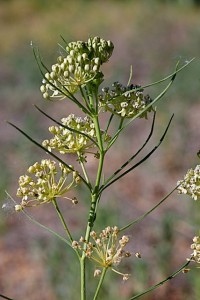
Poison Milkweed Asclepias subverticilla (photo: Janice Tucker)
Scientific (genus) name: Asclepias
Common name: Milkweed
Plant Family: Apocynaceae – Dogbane (Formerly Asclepiadaceae (Milkweed) Family
Article by Janice Tucker
The Milkweeds are disappearing. Monarch butterflies are in trouble.
The Milkweed’s habitats are disappearing, which threatens the monarch butterfly’s existence because it is the only host plant for the monarchs’ larvae. Building developments, roadside construction and herbicides have diminished the once plentiful Milkweed. There is also a lack of concern because this plant is often considered to be just a weed. To quote Ralph Waldo Emerson, “What is a weed? A plant whose virtues have not yet been discovered.” We are now discovering more of the virtues of the Milkweed and why we should try to stop its decline throughout North America.
Native to North America the Asclepias genus contains over 100 species. Formerly in the Asclepiadaceae (Milkweed) family, this perennial has been recently classified in the Apocynaceae (Dogbane) plant family. The thick, milky sap gives the plant its common name. This sap contains a type of latex along with other elements. Named for Asclepius, the Greek god of medicine, the Asclepias species have beneficial medicinal uses. However, ranchers avoid fields with Milkweed since most of the Asclepias species are toxic to livestock. Toxicity levels vary among the species.
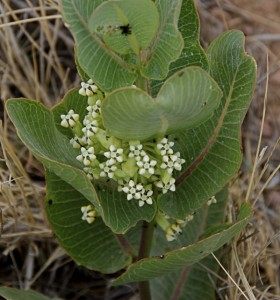
Broadleaf milkweed Asclepias latifolia (photo: Janice Tucker)
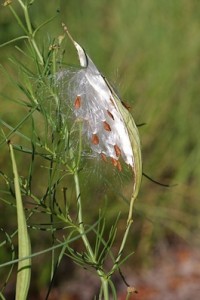
Poison milkweed seedpod (photo: Janice Tucker)
The growth habit of Milkweeds varies. They can be low-growing ground covers or plants that reach up to 5 feet in height, all depending on the species. Leaves can be slender like those of the Poison milkweed (Asclepias subverticillata) or very wide like those of the Broadleaf milkweed (Asclepias latifolia). Flowers appear in umbels of small, star-shaped flowers with puffy, hooded horns above the petals. Propagation is by hardy rhizomes and seeds. The seed pods (follicles) will split open when ripe, revealing seeds clinging to tufts of silky hairs. The seeds are dispersed when the wind catches the tufts to carry them away. The Santa Fe Botanical Garden’s Leonora Curtin Wetland Preserve has two species of Milkweed (Poison and Broadleaf). The Poison milkweed grows in some of the not yet developed areas of the Santa Fe Botanical Garden at Museum Hill.
Pollination of the Milkweed species is unique. The pollen is contained in pollen sacs (pollinarium), unlike most flowers that have loose, powdery pollen. Anthers of the flowers form narrow “slits”. When a flying, feeding insect visits the Milkweed, its legs fit into the slits. A pollen sac (pollinia) will attach itself to the insect’s leg as it flies away. Somehow this pollen sac will position itself just right so it can be neatly deposited into the stigma of the next Milkweed the insect visits. Monarch butterflies, other butterflies, and bees pollinate milkweed. Hummingbirds also like to feed on the Milkweed.
The twice a year, massive monarch migration is quite a phenomenon. These butterflies travel from Canada to Mexico, where they spend the winter and then from Mexico to Canada for their summer habitat. Although Milkweed is just one of the nectar plants for the monarch butterfly it is its only larva host for the monarch butterfly. If Milkweeds are not available along the migration path the monarchs cannot lay their eggs during the trip, which means no larvae to populate the numbers of monarch butterflies. Additionally, it is necessary for the butterflies to feed on plants to keep up their strength during their long journey. The disappearance of Milkweed habitats has had a huge negative impact on monarch butterfly propagation.
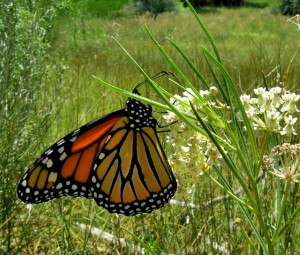
Monarch on Poison milkweed Asclepias subverticillata (photo: Janice Tucker)
So, how come the Milkweed and the monarch don’t destroy each other? Doesn’t the caterpillar kill the Milkweed as it feeds off its leaves? The caterpillars may cause some damage but it usually morphs into an adult before killing the plant. Gardeners can remove dead leaves and prune the plant back. Its hardy root system usually ensures it will come back. Then there is the question: Why doesn’t the toxic Milkweed kill the butterflies and their larvae that feed off its flowers and leaves? The monarch butterfly’s system can absorb the Milkweed’s toxins (cardiac glycosides) without being affected. These bad-tasting toxins are stored in the wings and exoskeletons, which serve as a survival tool. Predators learn quickly that noshing on a monarch butterfly could make them very sick, or that it could be a fatal, foul-tasting, last meal.
Current agricultural practices of using herbicides on crops that are immune to them have had a destructive effect on the Milkweed. Milkweeds thrive in fields and open areas and often grow between the rows of crop plants. The Milkweed’s root system can survive the earlier farming practice of tilling unwanted plants under the soil but cannot survive the modern, potent herbicides. Increases in building developments and roadside construction have also contributed to this problem. And as the Milkweed goes, so goes the monarch butterfly.
What can be done? There is a movement to save the monarch butterfly by increasing the Milkweed habitats throughout North America. For more information and suggestions of butterfly garden plants, read the accompanying monarch butterfly article. Contact the Monarch Watch organization – www.monarchwatch.org.
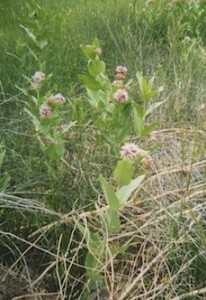
Showy Milkweed by Helen Woody
Plant a butterfly garden. It will be a delightful attraction not only to monarchs but also to other butterflies, hummingbirds and bees. Include a variety of plants that are both nectar sources and larvae hosts. A butterfly garden is a great way to observe nature and do something good for the environment. Some local nurseries can probably help with plant choices and there are many websites with good suggestions. (Santa Fe is in USDA zone 6b) Be sure to include Milkweed. Many species have lovely and sometimes fragrant flowers, even though some folks deride it as a weed. After all, in the words of Winnie the Pooh’s friend, Eeyore, “Weeds are flowers too, once you get to know them.”


